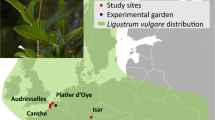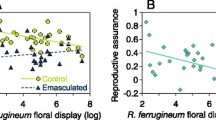Abstract
Genetic variation was shown earlier to bereduced in smaller populations of the narrowendemic putatively self-incompatible Cochlearia bavarica. To test whether thisnegatively affects plant fitness by reducedavailability of compatible mates and byinbreeding depression, we studied effects ofpopulation size and pollination treatments oncross-compatibility and offspring fitness in 16isolated populations of this plant. After openpollination, compatibility of crosses (i.e.,whether at least one fruit developed per markedflower), fruit set of compatible crosses, andcumulative fitness (number of plants permaternal ovule) after 14 months in a commongarden were lower for plants from smallerpopulations. Throughout the study, cumulativefitness was lower after hand pollination withpollen of one donor than after open pollination(finally 73.4% lower), suggesting that severalpollen donors or single pollen donors of higherquality are involved in open pollination.Moreover, cumulative fitness was lower afterhand selfing than after hand outcrossing(finally 69.4% lower), indicating bothinbreeding depression and reduced compatibilityafter selfing. High self-compatibility(40.6%), dry stigmas, and differences in thecompatibility of 11 of 33 experimentalreciprocal crosses between plant pairsconfirmed that C. bavarica has asporophytic self-incompatibility system, as iscommon in the Brassicaceae. Our studydemonstrates, that plants in smallerpopulations of species with a sporophyticself-incompatibility system can experiencetwofold fitness reductions associated withreduced genetic variability, i.e., twofoldgenetic Allee effects: via reducedcross-compatibility and via reduced offspringfitness.
Similar content being viewed by others
References
Abs C (1999) Differences in the life history of two Cochlearia species. In: Ecology of Closely Related Plant Sspecies (eds. Marhold K, Schmid B, Krahulec F), pp. 33-45. Opulus Press, Uppsala.
Byers DL (1995) Pollen quantity and quality as explanations for low seed set in small populations exemplified by Eupatorium (Asteraceae). American Journal of Botany, 82, 1000-1006.
Byers DL, Meagher TR (1992) Mate availability in small populations of plant species with homomorphic sporophytic selfincompatibility. Heredity, 68, 353-359.
Charlesworth D (1988) Evolution of homomorphic sporophytic selfincompatibility. Heredity, 60, 445-453.
De Mauro MM (1993) Relationship of breeding system to rarity in the Lakeside Daisy (Hymenoxys acaulis var. glabra). Conservation Biology, 7, 542-550.
De Nettancourt N (1977) Incompatibility in Angiosperms. Springer, New York.
Ellstrand NC, Elam DR (1993) Population genetic consequences of small population size:implication for plant conservation. Annual Reviews of Ecology and Systematics, 24, 217-241.
Fischer M, Matthies D (1998a) RAPD variation in relation to population size and plant fitness in the rare Gentianella germanica. American Journal of Botany, 85, 811-819.
Fischer M, Matthies D. (1998b) Effects of population size on performance in the rare plant Gentianella germanica. Journal of Ecology, 86, 195-204.
Fischer M, Husi R, Prati D, Peintinger M, van Kleunen M, Schmid B (2000) RAPD variation among and within small and large populations of the rare clonal plant Ranunculus reptans (Ranunculaceae). American Journal of Botany, 87, 1128-1137.
Fischer M, van Kleunen M, Schmid B (2000) Genetic Allee effects on performance, plasticity, and developmental stability in a clonal plant. Ecology Letters, 3, 530-539.
Heschel MS, Paige KN (1995) Inbreeding depression, environmental stress, and population size variation in scarlet gilia (Ipomopsis aggregata). Conservation Biology, 9, 126-133.
Husband BC, Barrett SCH (1992) Genetic drift and the maintenance of the style length polymorphism in trystylous populations of Eichhormia paniculata (Pontederiaceae). Heredity, 69, 440-449.
Husband BC, Schemske DW (1996) Evolution of the magnitude and timing of inbreeding depression in plants. Evolution, 50, 54-70.
Imrie BC, Kirkman CJ, Ross DJ (1972) Computer simulation of a sporophytic self-incompatible breeding system. Australian Journal of Biological Science, 25, 343-349.
Kearns CA, Inouye DW (1993) Techniques for Pollination Biologists. University Press of Colorado, Niwot, Colorado.
Kéry M, Matthies D, Spillmann HH (2000) Reduced fecundity and offspring performance in small populations of the declining grassland plants Primula veris and Gentiana lutea. Journal of Ecology, 88, 17-30.
Koch M (2002) Genetic differentiation and speciation in prealpine Cochlearia: Allohexaploid Cochlearia bavarica Vogt (Brassicaceae) compared to its diploid ancestor Cochlearia pyrenaica DC in Germany and Austria. Plant Systematics and Evolution, 232, 35-49.
Kowyama Y, Takahasi H, Muraoka K, Tani T, Hara K, Shiotani I (1994) Number, frequency and dominance relationships of S-alleles in diploid Ipomoea trifida. Heredity, 73, 275-283.
Les DH, Reinartz JA, Esselman EJ (1991) Genetic consequences of rarity in Aster furcatus (Asteraceae), a threatened, selfincompatible plant. Evolution, 45, 1641-1650.
Mather K, Jinks JL (1977) Introduction to Biochemical Genetics. Cornell University Press, Ithaca, New York.
Menges ES (1991) Seed germination percentage increases with population size in a fragmented prairie species. Conservation Biology, 5, 158-164.
Ohara M, Takeda H, Ohno Y, Shimamoto Y (1996) Variations in the breeding system and the population genetic structure of Trillium kamtschaticum (Liliaceae). Heredity, 76, 476-484.
Oostermeijer JGB, van Eijck MW, den Nijs JCM (1994) Offspring fitness in relation to population size and genetic variation in the rare perennial plant species Gentiana pneumonanthe (Gentianaceae). Oecologia, 97, 289-296.
Paschke M, Abs C, Schmid B (2002a) Effects of population size and pollen diversity on reproductive success and offspring size in the narrow endemic Cochlearia bavarica (Brassicaceae). American Journal of Botany, 89, 1250-1259.
Paschke M, Abs C, Schmid B (2002b) Relationship between population size, allozyme variation, and plant performance in the narrow endemic Cochlearia bavarica. Conservation Genetics, 3, 131-144.
Ramsey M, Vaughton G (1996) Inbreeding depression and pollinator availability in a partially self-fertile perennial herb Blandfordia grandiflora (Liliaceae). Oikos, 76, 465-474.
Reinartz JA, Les DH (1994) Bottleneck-induced dissolution of self-incompatibility and breeding system consequences in Aster furcatus (Asterasceae). American Journal of Botany, 81, 446-455.
Richards A (1986) Plant Breeding Systems. Allen and Unwin, London.
Roach DA, Wulff RD (1987) Maternal effects in plants. Annual Review of Ecology and Systematics, 18, 209-235.
Steiner W (1992) Inkompatibilitätssysteme bei Pflanzen und ihre populationsgenetische Bedeutung. PhD thesis, University of Göttingen.
Stephens PA, Sutherland WJ, Freckleton RP (1999) What is the Allee effect? Oikos, 87, 185-190.
Stevens JP, Kay QON (1988) The number of loci controlling the sporophytic self-incompatibility system in Sinapis arvensis L. Heredity, 61, 411-418.
Stevens JP, Kay QON (1989) The number, dominance relationships and frequencies of self-incompatibility alleles in a natural population of Sinapis arvensis L. in South Wales. Heredity, 62, 199-205.
Stewart-Oaten A (1995) Rules and judgements in statistics: three examples. Ecology, 76, 2001-2009.
Vogt R (1985) Die Cochlearia pyrenaica-Gruppe in Zentraleuropa. Berichte der Bayerischen Botanischen Gesellschaft, 59, 133-135.
Waller DM (1993) The statics and dynamics of mating system evolution. In: The Natural History of Inbreeding and Outbreeding (ed. Wilmsen Thornhill N), pp. 97-117. Chicago University Press, Chicago.
Waser NM (1993) Sex, mating systems, inbreeding, and outbreeding. In: The Natural History of Inbreeding and Outbreeding (ed. Wilmsen Thornhill N), pp. 1-13. Chicago University Press, Chicago.
Wolf AT, Harrison SP, Hamrick JL (2000) Influence of habitat patchiness on genetic structure and spatial structure of a serpentine endemic plant. Conservation Biology, 14, 454-463.
Wyatt R (1983) Pollination and fruit set in Asclepias:a reappraisal. American Journal of Botany, 63, 845-851.
Young AG, Boyle T, Brown T (1996) The population genetic consequences of habitat fragmentation for plants. Trends in Ecology and Evolution, 11, 413-418.
Young AG, Brown AHD, Zich FA (1999) Genetic structure of fragmented populations of the endangered daisy Rutidosis leptorrhynchoides. Conservation Biology, 13, 256-265.
Author information
Authors and Affiliations
Corresponding author
Rights and permissions
About this article
Cite this article
Fischer, M., Hock, M. & Paschke, M. Low genetic variation reduces cross-compatibility and offspring fitness in populations of a narrow endemic plant with a self-incompatibility system. Conservation Genetics 4, 325–336 (2003). https://doi.org/10.1023/A:1024051129024
Issue Date:
DOI: https://doi.org/10.1023/A:1024051129024




